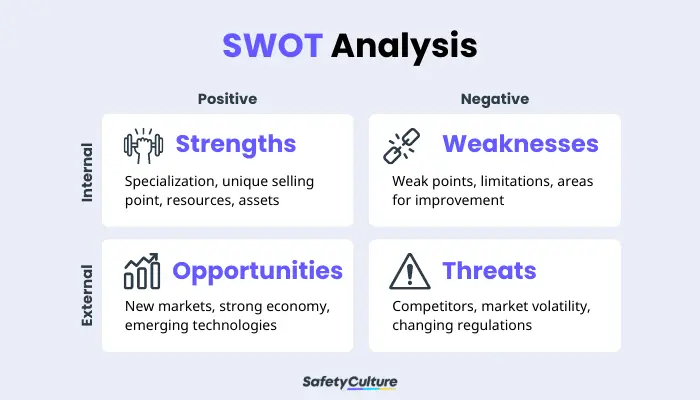What is a SWOT Analysis?
SWOT stands for Strengths, Weaknesses, Opportunities, and Threats, and a SWOT analysis is a document that aims to analyze a business’s competitive position to make informed decisions on future strategies. SWOT analysis is commonly used as part of an organization’s effort to improve existing processes or create new ones.
History
The idea of SWOT can be credited to Albert Humphrey, who developed it in the 1960s and 1970s during his stay at the Stanford Research Institute (SRI). He came up with the idea while he was conducting a study to identify and understand the reasons why certain corporate plans and their methods repeatedly failed. In order to help companies create more long-term and sustainable ways of corporate planning, he developed the SWOT framework.
Today, conducting a SWOT analysis has become more commonplace. The primary purpose and goal of conducting a SWOT analysis are to analyze and reinforce one’s business strategies by assessing the business’s strengths, weaknesses, potential opportunities, and threats in its specific target market.
Purpose
The main purpose of a SWOT analysis is to improve a business’s plans, products, and services. Similar to the Lean and Kaizen frameworks, a SWOT analysis can also be used for continuous improvement, as it encourages leaders and their staff to consciously note their strengths and weaknesses and discuss points of change. Having a SWOT analysis can also help with setting relevant, attainable, and sustainable goals.
A SWOT analysis can be used at any step of a business plan to organize thoughts, improve discussions, and better understand goals, but it is highly recommended to use one during any project or policy discussion’s planning stage. Using a SWOT analysis before any company action, new initiative, and policy change can aid in assessing the current landscape of one’s business first, which can help with making decisions in general. Doing so can also help identify the exact points for improvement early on, which helps lessen the chances of making large unnecessary changes and overhauls. In this way, a SWOT analysis can also help in saving time, and money, and preventing major risks, making it an important planning tool.
Components of a SWOT Analysis
When it comes down to identifying one’s SWOT traits, ask the questions:

SWOT Analysis
- Strengths: What are the company’s advantages over others?
- Weaknesses: In what way is the company underperforming or having issues?
- Opportunities: What are points of improvement for the company internally or externally? Where can new technologies and strategies be implemented?
- Threats: How can the company be put at risk? What factors can put the company at a disadvantage compared to its competitors? Threats can include a volatile industry and new competitors.
Achieve operational excellence
Cultivate a culture of excellence with our digital solutions that enhance efficiency, agility, and continuous improvement across all operations.
Explore nowHow to Conduct a SWOT Analysis
The process followed is the way the name is structured, that is, in the order of Strengths, Weaknesses, Opportunities, and Threats.
1. List down traits based on each component
Identify the company’s strengths and weaknesses first, then the opportunities they can have based on them, and the threats that may come their way. Listing down weaknesses and threats in particular plays a large role in highlighting company issues, as noting internal and external issues together helps paint a coherent picture of company affairs. On the other hand, identifying strengths and opportunities help motivate the company employees better, work harder, and create goals.
2. Put Swot Analysis in a table
The typical SWOT analysis is done in a table with four columns, with each column corresponding to Strengths, Weaknesses, Opportunities, and Threats. In some cases, rather than a four-column table, others opt to use a 2×2 table instead, with the top rows corresponding to Strengths and Weaknesses, while the bottom row is for listing Opportunities and Threats.
3. Use a digital checklist
Besides tables, a new way of conducting a SWOT analysis is through checklists. While not necessarily as visual, using a checklist makes it easier to conduct a SWOT analysis on the go thanks to its straightforward structure and ease of use. A checklist is also easier to modify as needed, making it easier for multi-industry use. Digital checklists, in particular, are best for on-the-go and flexible use.
SWOT Analysis Template
Use this template to systematically analyze a business’s strengths, weaknesses, opportunities, and threats. A diverse range of colleagues should be involved in conducting a SWOT analysis, which should be reviewed at least annually or if there are any significant changes internally or externally.

Create your own SWOT Analysis template
Build from scratch or choose from our collection of free, ready-to-download, and customizable templates.
Browse SWOT Analysis templateSWOT Analysis Example
To better illustrate how a SWOT analysis works, here is an example:
A certain canned beverage company would like to improve its marketing strategies for the incoming fiscal year. To do so, they decided to conduct a SWOT analysis on themselves.
For their Strengths, they found that:
|
On the other hand, this beverage company found that its Weaknesses were;
|
With these findings in mind, the company went on to try predicting and analyzing their Opportunities and Threats based on them.
The main Opportunity that the company found was that they can easily branch out to more markets and countries with their influence. Other Opportunities the company found that they could tap into is utilizing social media for better promoting their products and for targeting a younger audience. Using new means of advertisement was never really a priority for them, but this finding has caused them to reconsider.
On the other hand, however, the company found that the advancement in technologies may also be a Threat to their business. They acknowledge that they may not be able to keep up with it, and this is something that they need to change.
Following its SWOT analysis, the beverage company has decided to invest more in digital advertising and marketing. After seeing successful results from the change, the company decided to carry on with it and conduct another SWOT analysis the next year.
FAQs about SWOT Analysis
As a SWOT analysis can be done for self-improvement, anyone can do it on their own. However, for corporations and teams, it is more common for the CEO or other key leaders to take initiative in conducting a SWOT analysis, as they will have the most ideas. On the other hand, sometimes, the leader in charge may choose to assign someone in their team to lead the discussion and generate ideas instead.
A TOWS analysis is considered a counterpart or extension of the SWOT analysis. While SWOT stands for Strengths, Weaknesses, Opportunities, and Threats, TOWS stands for Threats, Opportunities, Weaknesses, and Strengths. This means a TOWS analysis starts with analyzing external factors first before internal ones, unlike a SWOT analysis that looks to prioritize internal findings and issues first. Adopting both frameworks can help greatly in creating business plans.
Some common complementary frameworks or analyses that can be used with a SWOT analysis are:
- Environmental analysis techniques
- Gap analysis techniques
- TOWS framework
- PESTLE framework
- Scenario planning
- Other strategic analysis frameworks
PESTLE is an analytical framework that focuses on understanding a business’ macro-environment by analyzing its Political, Economic, Social, Technological, Legal, and Environmental (PESTLE) factors. The main difference between the two is that a SWOT analysis focuses on addressing a business’ internal issues or making changes internally, while a PESTLE analysis focuses on the external factors instead.



